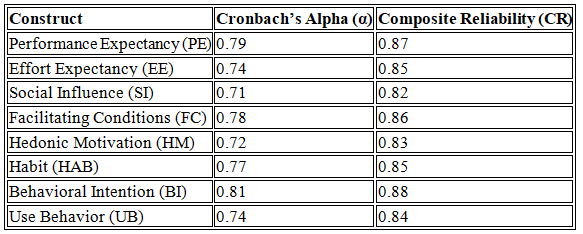Adoption of Mobile Payment Systems: An Empirical Analysis of Consumer Intentions using the UTAUT2 Model and PLS-SEM
DOI:
https://doi.org/10.5281/zenodo.17212169Keywords:
mobile payment adoption, utaut2, consumer behavior, digital finance, financial inclusionAbstract
Mobile payment systems have emerged as a key driver of financial inclusion in India, particularly in the context of digital transformation and the government’s push toward a cashless economy. This study investigates the determinants influencing consumer adoption of mobile payment systems using the Unified Theory of Acceptance and Use of Technology 2 (UTAUT2) model. A structured questionnaire was administered to 124 respondents in Jharkhand, India, and data were analyzed using Partial Least Squares–Structural Equation Modeling (PLS-SEM) in SmartPLS. The results reveal that performance expectancy, effort expectancy, facilitating conditions, hedonic motivation, and price value significantly influence behavioral intention to use mobile payments, whereas social influence, trust, and habit were found to be insignificant predictors. Furthermore, behavioral intention showed a positive and significant effect on actual usage behavior. These findings provide empirical support for UTAUT2 in the Indian context and highlight the growing role of perceived value and technological convenience in shaping mobile payment adoption. The study offers theoretical contributions to digital finance literature and practical implications for policymakers, fintech firms, and service providers aiming to enhance mobile payment penetration in emerging economies.
Downloads
References
Ajzen, I. (1991). The theory of planned behavior. Organizational Behavior and Human Decision Processes, 50(2), 179–211. https://doi.org/10.1016/0749-5978(91)90020-T
Alalwan, A. A., Dwivedi, Y. K., & Rana, N. P. (2017). Factors influencing adoption of mobile banking by Jordanian bank customers: Extending UTAUT2 with trust. International Journal of Information Management, 37(3), 99–110. https://doi.org/10.1016/j.ijinfomgt.2017.01.002
Baptista, G., & Oliveira, T. (2015). Understanding mobile banking: The unified theory of acceptance and use of technology combined with cultural moderators. Computers in Human Behavior, 50, 418–430. https://doi.org/10.1016/j.chb.2015.04.024
Chin, W. W. (1998). The partial least squares approach to structural equation modeling. In G. A. Marcoulides (Ed.), Modern methods for business research (pp. 295–336). Lawrence Erlbaum Associates.
Davis, F. D. (1989). Perceived usefulness, perceived ease of use, and user acceptance of information technology. MIS Quarterly, 13(3), 319–340. https://doi.org/10.2307/249008
Escobar-Rodríguez, T., & Carvajal-Trujillo, E. (2014). Online purchasing tickets for low-cost carriers: An application of the unified theory of acceptance and use of technology (UTAUT) model. Tourism Management, 43, 70–88. https://doi.org/10.1016/j.tourman.2014.01.017
Gupta, A., & Arora, N. (2020). Investigating behavioral intention to accept mobile payment systems through an extended UTAUT2 model: An Indian perspective. International Journal of Management Practice, 13(2), 135–157. https://doi.org/10.1504/IJMP.2020.106084
Hair, J. F., Hult, G. T. M., Ringle, C. M., & Sarstedt, M. (2021). A primer on partial least squares structural equation modeling (PLS-SEM). (3rd ed.). Sage.
Henseler, J., Ringle, C. M., & Sarstedt, M. (2015). A new criterion for assessing discriminant validity in variance-based structural equation modeling. Journal of the Academy of Marketing Science, 43(1), 115–135. https://doi.org/10.1007/s11747-014-0403-8
Hofstede, G. (2001). Culture’s consequences: Comparing values, behaviors, institutions and organizations across nations. (2nd ed.). Sage.
Hossain, M. A., Kim, M., & Jahan, N. (2020). Investigating mobile payment adoption in Bangladesh: An application of UTAUT2. Sustainability, 12(18), 7436. https://doi.org/10.3390/su12187436
Limayem, M., Hirt, S. G., & Cheung, C. M. K. (2007). How habit limits the predictive power of intention: The case of IS continuance. MIS Quarterly, 31(4), 705–737. https://doi.org/10.2307/25148817
Morosan, C., & DeFranco, A. (2016). It’s about time: Revisiting UTAUT2 to examine consumers’ intentions to use NFC mobile payments in hotels. International Journal of Hospitality Management, 53, 17–29. https://doi.org/10.1016/j.ijhm.2015.11.003
Oliveira, T., Thomas, M., Baptista, G., & Campos, F. (2016). Mobile payment: Understanding the determinants of customer adoption and intention to recommend the technology. Computers in Human Behavior, 61, 404–414. https://doi.org/10.1016/j.chb.2016.03.030
Patil, P., Tamilmani, K., Rana, N. P., & Raghavan, V. (2020). Understanding consumer adoption of mobile payment in India: Extending Meta-UTAUT model with personal innovativeness, anxiety, trust, and grievance redressal. International Journal of Information Management, 54, 102144. https://doi.org/10.1016/j.ijinfomgt.2020.102144
Sharma, G., & Sharma, N. (2019). Examining the role of trust and quality dimensions in the actual usage of mobile banking services: An empirical investigation. International Journal of Information Management, 44, 65–75. https://doi.org/10.1016/j.ijinfomgt.2018.09.013
Sharma, R., & Sinha, A. (2021). Adoption and usage of mobile payment in India: An empirical study. FIIB Business Review, 10(2), 152–162. https://doi.org/10.1177/2319714520964564
Singh, N., & Sinha, N. (2020). How perceived trust mediates the impact of perceived usefulness and security on continuance intention for mobile payment apps. Journal of Retailing and Consumer Services, 55, 102086. https://doi.org/10.1016/j.jretconser.2020.102086
Sivathanu, B. (2019). Adoption of digital payment systems in the era of demonetization in India: An empirical study. Journal of Science and Technology Policy Management, 10(1), 143–171. https://doi.org/10.1108/JSTPM-07-2017-0033
Slade, E. L., Williams, M. D., Dwivedi, Y. K., & Piercy, N. C. (2015). Exploring consumer adoption of proximity mobile payments. Journal of Strategic Marketing, 23(3), 209–223. https://doi.org/10.1080/0965254X.2014.914075
Venkatesh, V., Morris, M. G., Davis, G. B., & Davis, F. D. (2003). User acceptance of information technology: Toward a unified view. MIS Quarterly, 27(3), 425–478. https://doi.org/10.2307/30036540
Venkatesh, V., Thong, J. Y. L., & Xu, X. (2012). Consumer acceptance and use of information technology: Extending the unified theory of acceptance and use of technology. MIS Quarterly, 36(1), 157–178. https://doi.org/10.2307/41410412
Williams, M. D., Rana, N. P., & Dwivedi, Y. K. (2015). The unified theory of acceptance and use of technology (UTAUT): A literature review. Journal of Enterprise Information Management, 28(3), 443–488. https://doi.org/10.1108/JEIM-09-2014-0088
Zhou, T. (2013). An empirical examination of initial trust in mobile payment. Wireless Personal Communications, 77(2), 1519–1531. https://doi.org/10.1007/s11277-013-1511-1

Published
How to Cite
Issue
Section
License
Copyright (c) 2025 Ankita Kumari

This work is licensed under a Creative Commons Attribution 4.0 International License.
Research Articles in 'Management Journal for Advanced Research' are Open Access articles published under the Creative Commons CC BY License Creative Commons Attribution 4.0 International License http://creativecommons.org/licenses/by/4.0/. This license allows you to share – copy and redistribute the material in any medium or format. Adapt – remix, transform, and build upon the material for any purpose, even commercially.









